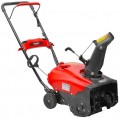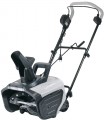Motor type
—
Petrol. An internal combustion engine that uses gasoline as fuel. Such engines are often more powerful than electric ones, and do not depend on being connected to the mains or the length of the power cord. On the other hand, gasoline snow blowers are usually heavier, have a higher noise level, and emit combustion products into the air. In addition, they are more expensive to operate and require the purchase of fuel and lubricants. You should pay attention to such machines if you plan to work on large areas and/or in the absence of electricity.
—
Diesel. Internal combustion engines running on diesel fuel. It is easier to achieve high torque in such engines than in gasoline engines; however, this requires sacrificing speed, but this is not critical for snow blowers. In addition, diesel fuel is cheaper than gasoline. On the other hand, the engines themselves are quite expensive and difficult to maintain, and at low temperatures they often have problems starting. Therefore, diesel engines are not very widespread; they are found only in a few models of heavy professional snow blowers.
—
Electric(mains). Snow blowers with electric motors are usually powered by a regular 230 V mains. Compared to gasoline ones, such devices are lighter, cheaper to operate, produce less noise and do not pollute the air; in addition, they are more compact and easier to store. On th
...e other hand, the power of electric snow blowers is usually significantly lower, and mobility is limited by the length of the power cord. Such models can be recommended primarily to those who plan to clean relatively small areas in the immediate vicinity of power sources - for example, the yard of a private house or the exit from a garage.
— Electric (battery). Snow blowers with an electric motor, powered by a built-in battery. Such models have very low power and limited operating time, while they are more expensive and weigh more than their mains-powered counterparts. On the other hand, a battery-powered snow blower works without being connected to the mains and does not depend on the length of the wire. So such a unit will be an ideal choice for cleaning a relatively small area near which there are no sockets.Working width
The width of the strip of snow that the snow blower can clear in one pass. The larger the capture width, the fewer passes will be required to process the site, which is especially important on large areas. On the other hand, for processing small spaces, clearing individual paths, etc. significant width is not required (moreover, a “narrow” snow blower will pass more easily in a hard-to-reach place). The larger the capture width, the more powerful the engine, usually, ceteris paribus.
The most compact modern snow blowers have a working width of
less than 50 cm, these are mainly electric models of low power, although gasoline units are also found. A width of
50 – 60 cm can be called relatively small,
60 – 70 cm — medium, and in the largest models this figure
exceeds 70 cm.
Max. throw distance
The maximum distance to which the snow blower can throw the collected snow (for models without throwing distance adjustment, the operating range itself). This value is rather arbitrary, since snow can be strongly dispersed in flight. Nevertheless, it characterizes the capabilities of the unit well and allows you to compare it with other models.
Long range is important mainly when working on large areas — it allows you to throw snow across the cultivated area so that it does not have to be collected a second time. As for specific figures, the value
up to 10 m is considered relatively small,
11 – 15 m — average, and in the most "long-range" models this figure can be
16 m or more.
Design
—
Self-propelled design. In self-propelled snow blowers, the built-in motor drives not only the auger, but also the wheels / tracks, ensuring the movement of the device. In this way, you do not have to push the snow blower by hand, which makes work much easier — especially with heavy, powerful models. Most self-propelled models have a transmission that allows you to adjust the speed of movement, as well as the ability to move backward (see "Number of gears").
—
Overload protection. A safety system that protects the unit from breakdowns in the event of critical loads. The main reason for the occurrence of such loads is the jamming of the screw — for example, due to the ingress of a foreign object. Therefore, most often, special bolts are used for protection, connecting the auger to the motor gearbox: with a sharp increase in load, the bolts are cut off and the auger is disconnected from the gearbox. Another option is overheating protection that reacts to engine temperature; it is found predominantly in electrical assemblies and can be used alone or in combination with shear bolts.
—
Headlights. The presence of a headlight (headlights) in the design of the snow blower allows you to use it for work at night, when there are no other light sources or they are not enough. In addition, in some models, the headlights turn on automatically every time the engine is starte
...d — they play the role of a warning signal that the unit is running.
— Heated handles. Heating system for handles, which the operator holds during work. This feature is especially useful as snow blowers are used in cold weather, and hands can get cold during prolonged use. On the other hand, with small volumes of cleaning, you can completely do with gloves, so heated handles are found mainly in powerful models with internal combustion engines, designed for large volumes of work.Engine size
The size of the engine installed in a gasoline or diesel (see "Engine type") snow blower. With the same type of internal combustion engine (see above), more displacement usually means more power and more fuel consumption.
Motor power
Snowblower motor power in horsepower.
The universal unit of power today is watts, but for petrol and diesel engines (see "Motor type"), the traditional designation in horsepower may also be given. 1 HP approximately equal to 735 watts.
The higher the motor power, the higher the performance of the snow blower, the better it handles with high dense snowdrifts and icy crust. However, more powerful engines consume more fuel, weigh more and cost more, and their use is not always justified. Detailed recommendations on choosing the optimal power for a specific situation can be found in special sources.
Motor power
Snowblower motor power in watts. This designation is used for all electric models; for units with an internal combustion engine (see "Motor type"), the designation in horsepower may also be given (see above).
The higher the motor power, the higher the snowblower's flow rate, the better it copes with high dense snowdrifts and icy crust. However, more powerful engines consume more fuel, weigh more and cost more, and their use is not always justified. Detailed recommendations on choosing the optimal power for a specific situation can be found in special sources.
Starter
The method of starting motor (see "Motor type") of petrol snow blower. Today, the following options are available:
— Manual (starter rope). The simplest way to start: the operator pulls the cable, which turns the shaft and gives the engine the necessary initial impulse. Such starting systems are the most compact, simple and inexpensive, and they do not depend on power sources. On the other hand, it makes sense to use cables mainly in light and low-power snow blowers - to start heavy units, significant force is required, which is easier to provide with an electric starter.
—
Electric starter (230 V mains). Starting with an electric starter powered by a 230 V network (a regular socket). An electric starter is a small electric motor that turns the engine shaft when starting, giving it an initial impulse. Such systems are more complex, heavier and more expensive than cables, but are suitable even for the heaviest and most powerful engines; and the start itself is extremely simple - the user only needs to press a button. At the same time, power from the network allows you to do without heavy and expensive batteries. True, the network itself is required for starting, but this usually does not cause any special problems; and in case the snow blower stalls "in an open field", a backup starting system is usually provided in the form of the same cable. Therefore, most units with electric starters use power from the network.
...
— Electric starter (battery). Starting with an electric starter powered by a battery installed in the snow blower. For general features of electric starters, see above, and battery power makes the starting system as autonomous as possible: the starter can be used regardless of the presence of sockets nearby, and the battery is recharged from the running engine if necessary. On the other hand, the presence of a battery affects the cost and weight of the unit, and the mentioned autonomy is required relatively infrequently. Therefore, electric starters on batteries are used only in certain models of high-performance snow blowers designed for long-term operation "in the field", away from power grids; the weight and price of the battery in such cases are insignificant compared to the weight and price of the unit itself.Fuel tank volume
The amount of fuel that the snow blower tank can hold at one time. Knowing this figure, as well as fuel consumption (see above), you can easily calculate the approximate operating time on one gas station. However, manufacturers usually choose the volume so that the operating time reaches at least 2 – 2.5 hours, so in most cases you can not pay much attention to this parameter.

